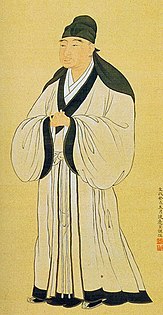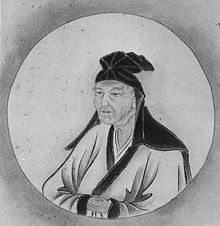Shenyi
[3][1]: 12 Thus, the shenyi differ structurally from the paofu, which is a one-piece robe where the lower and upper part is cut in a single fabric.
[12][13] Out of convenience, the yi and chang were sewn together to form a robe;[14] this combination then resulted into the shenyi which was developed in the Zhou dynasty.
[18]: 16 The preoccupation of the elites with layered, loose-fitting clothing also displayed their desire to distance themselves from the labourers, signalling their high status.
[16]: 255 The shenyi was also shaped by the Zhou dynasty's hierarchical system based on social class, gender, age, and the situation.
[23] In this period, the shenyi was also deeply rooted in the traditional Chinese ethics and morals which forbid close contacts between males and females.
The sleeve was joined to the body of the dress at the armpit, so as to allow the freest movement of the elbow-joint; the length of the lower part admitted of the cuffs being turned back to the elbow.
[22] It also prescribed the rules on the colours and decorations of the trims based on the circumstances of its wearer:[22] For ornament, while his parents and grandparents were alive, (a son) wore the dress with its border embroidered.
[《具父母、大父母,衣純以繢;具父母,衣純以青。如孤子,衣純以素。純袂、緣、純邊,廣各寸半。》]Moreover, in addition to the prescribed rules and regulations present in the chapter Shenyi《深衣》, more details can be found in the chapter Yuzao《玉藻》of the Liji which described the shenyi as having a youren opening,[11] and being a one-piece long robe with broad sleeve openings; with its circumference at the waist be three times that of the sleeve-opening and that of its hem be even larger:[24] In the morning they wore the xuanduan; in the evening, the shenyi.
[22][25] These four tools have normative connotations in Liji: The gui, ju, and sheng generally refer to the rules and standards people should follow; the quanheng defines the ability to balance all the advantages and disadvantages and result in the best solution.
The Liji also implies that the symbolic meanings of the shenyi which may be sensed by the wearer's body, in addition to being accessed cognitively and mentally.
Both the Chinese verbs "to carry" (fu) and "to embrace" (bao) employed regarding the straight seams and square-shaped neckline frequently indicate a close bodily relationship between its subject and object.
Moreover, the evenness of the bottom border of the shenyi may be sensed when the wearer stretches it with his hands or when his thighs naturally meet it while walking.
[11] This can be observed in the Mashan tombs, where a lady, who was a member of the shi class,[note 1] was buried sometimes around the year 340 – 278 BC with twelve long robes which were all cut in the approximate style of shenyi whether they were padded with silk floss (mianpao), single in layer (danyi) or lined (jiayi).
[11][note 2] During the Qin and Han dynasties, the shenyi dominated the connection method of the upper and lower parts and became the mainstream choice.
[26]: 16 By the Western Han dynasty, the shape of the shenyi had deviated from the earlier versions as it can be found in the Mawangdui tomb of the same period belonging to Lady Dai.
[11] More examples of unearthed archeological artefacts of shenyi made of diverse cuts and materials from the Mawangdui tomb can be found in Museums, such as the zhijusushadanyi (Chinese: 直裾素纱襌衣; pinyin: zhíjūsùshādānyī; lit.
According to the Fangyan by Yang Xiong dating from the Western Han dynasty, the danyi (Chinese: 襌衣; lit.
There were also gradual changes but clear distinctions in the form of the shenyi between the early and late period of the Western Han dynasty.
[27] In the Song dynasty, Neo-Confucian philosophies determined the conduct code of the scholars which then had a great influence on the lives of the people.
[35]: 184 Zhu Xi and his Neo-Confucian colleagues developed a new cosmology, moral philosophy, and political principles based on intellectuals and elites sharing responsibility for the dynasty's management.
[10] However, the shenyi used as a scholar gown was not popular in the Song dynasty and was even considered as "strange garment" despite some scholar-officials appreciated it.
The garment was worn by court officials, noblemen and noblewomen, palace ladies, scholars and their wives, artisans, merchants, and farmers.
[10] Moreover, the shenyi had become a symbol of status and Han ethnicity as it was devoid of all foreign influence and also denoted Chinese intellectual pride and superiority.
Ren was casually marked in the center of Huang Runyu's rendition and referred to the entire front piece, folding over the other side.
[36] Kang Youwei, who was an influential advocate of reforms in late Qing dynasty to the early Republican period,[37] rejected the idea that Confucianism was defective when compared to Christianity.
[37] Thus, in the written by Cheng Huanzhang also wrote the Kongjiaolun, where he argued that the rufu was the clothing attire worn by the Confucianism religion priests.
[38] However, despite the support of the prominent literati following the opening of the Kongjiao hui, which had also become the most illustrious and influential organization of its time,[38] the parliament voted to not accord an official recognition to Confucianism as a ‘religion’ in both 1913 and 1916; the parliament gave official institutional status to five religions: Buddhism, Daoism, Catholicism, Protestantism, and Islam, and excluded Confucianism.
[1]: 13–14 [12] The qujupao would curve and wraps the dress to the back of its wearer[11] allowing the contrasting or decorative edging of the robe would create a spiralling effect when encircling the body.
'winding lapel deep clothing'); this version of the qujupao can typically be found in the Mawangdui tomb No.1 of the Western Han dynasty.
[6][9]The early Tokugawa period in Japan, some Japanese scholars, such as Seika Fujiwara and Hayashi Razan, who self-proclaimed themselves as followers of Zhu Xi wore the Confucian shenyi and gave lectures in it.












